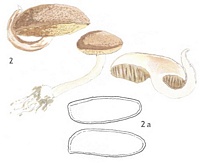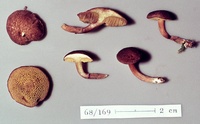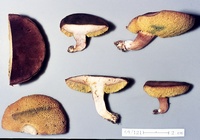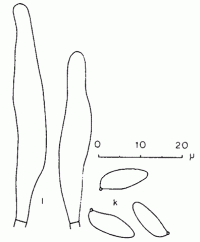|
 Xerocomus lentistipitatus Xerocomus lentistipitatus
SynonymsBoletellus lentistipitatus
Boletellus stipitatus
BiostatusPresent in region - Indigenous. Endemic
Images (click to enlarge)
Caption: Plate 2: 2, Boletellus lentistipatus, nat. size; 2a, spores, x 2000
Owner: PDD | 
Caption: ZT68-169
Owner: E. Horak: © Creative Commons Attribution-Noncommercial 3.0 New Zealand | 
Caption: ZT69-121
Owner: E. Horak: © Creative Commons Attribution-Noncommercial 3.0 New Zealand | 
Caption: Fig. 2 - k, l, Xerocomus lentistipitatus: k, spores; l, cystidia | |
Article: McNabb, R.F.R. (1968). The Boletaceae of New Zealand. New Zealand Journal of Botany 6(2): 137-176 (http://www.rsnz.org/publish/abstracts.php).
Notes: The short, smooth-walled
spores and hymenophoral trama of the Phylloporus subtype indicate that this
species belongs in the Boletaceae rather than Strobilomycetaceae. It readily
fits within Xerocomus, but in the absence of information on the ammonia reaction
of fresh pilei it is not possible to assign it to one of the sections recognised
by Singer (1962).
X. lentistipitatus may be recognised by the dry, pallid
brown to cinnamon brown pileus, yellow hymenophore, and pallid stipe. The presence
of basal rhizomorphs appears to be a relatively constant character.
Article: Stevenson, G. (1962) [1961]. The Agaricales of New Zealand: I. Kew Bulletin 15(3): 381–385.
Description: Pileus 2.5-4 cm. diam., dry, light brown, surface fibrillose floccose, velvety when young; cuticle of interwoven hyphae; flesh soft, creamy, becoming slightly pink when cut. Pores variable in size, up to 2 mm. diam., tubes 4 mm. long, dull yellow, depressed round the stipe; hymenophoral trama divergent. Stipe 4 cm. X 3-4 mm., tough, unequal, pale fawn at top, darker or white at rooting base, some with attached rhizomorphs; flesh fawn coloured. Spores 10-12 X 5um., light brown, with moderately thick walls indistinctly marked with broken longitudinal ridges.
Habitat: on fallen Nothofagus solandri in the Hutt Valley, 8.6.1952, P. Boswell, and at Puramahoi, Nelson, 20.4.1945, Dorothy Read.
|